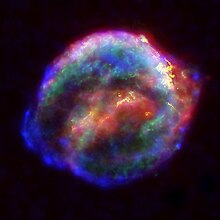Washington DC: Researchers have identified a supernova remnant - known as G352.7-0.1 (or, G352 for short) - that has swept material, equivalent to about 45 times the mass of the Sun.
Another atypical trait of G352 is that it has a very different shape in radio data compared to that in X-rays. Most of the radio emission is shaped like an ellipse, contrasting with the X-ray emission that fills in the center of the radio ellipse.
 |
| Multiwavelength composite image of the remnant of Kepler's supernova |
This is seen in a new composite image of G352 that contains X-rays from NASA's Chandra X-ray Observatory in blue and radio data from the National Science Foundation's Karl G. Jansky Very Large Array in pink.
A recent study suggests that, surprisingly, the X-ray emission in G352 is dominated by the hotter (about 30 million degrees Celsius) debris from the explosion, rather than cooler (about 2 million degrees) emission from surrounding material that has been swept up by the expanding shock wave.
This is curious because astronomers estimate that G352 exploded about 2,200 years ago, and supernova remnants of this age usually produce X-rays that are dominated by swept-up material. Scientists are still trying to come up with an explanation for this behavior.
G352 is found about 24,000 light-years from Earth in the Milky Way galaxy.
A supernova remnant (SNR) is the structure resulting from the explosion of a star in a supernova. The supernova remnant is bounded by an expanding shock wave, and consists of ejected material expanding from the explosion, and the interstellar material it sweeps up and shocks along the way.
There are two common routes to a supernova: either a massive star may run out of fuel, ceasing to generate fusion energy in its core, and collapsing inward under the force of its own gravity to form a neutron star or a black hole; or a white dwarf star may accumulate (accrete) material from a companion star until it reaches a critical mass and undergoes a thermonuclear explosion.

Thanks for sharing this informative information with us. I enjoyed stopping by your blog for these informative details that you provided. Have a great rest of your day.
ReplyDeleteGreg Prosmushkin